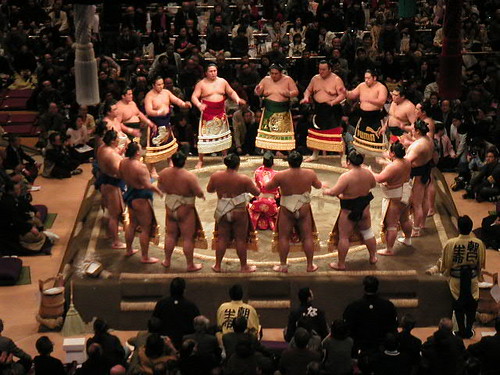skip to main |
skip to sidebar
Sumo

The changing world of sumo
The playoff between the Mongolian-born grand champion Asashoryu and Bulgarian Kotooshu on the final day of the Autumn Grand Sumo Tournament stirred great excitement Sunday. It was Asashoryu's sixth straight Emperor's Cup victory. The deciding bout symbolized a trend that has been brightening the lackluster mood in the sumo world for some time.
The first foreign-born sumo wrestler in postwar Japan was Takamiyama. The Hawaiian, known as Jesse, came to Japan in 1964 and quickly became hugely popular. He was followed by a trickle of sumo aspirants from overseas. However, those numbers surged in the 1990s. Fifty-nine non-Japanese professional sumo wrestlers are currently active. They include 12 in makuuchi, accounting for nearly one-third of all wrestlers in the senior division.
For years, the trail blazed by Takamiyama was followed mostly by Hawaiians. But in recent years, the home countries of foreign-born wrestlers have rapidly diversified. In addition to Japan, 12 nations are now represented. They include Mongolia, South Korea and China, along with countries in the South Pacific, Europe and South America.
Globalization is changing the face of sumo. The performances by massive Hawaiian wrestlers like Konishiki, Akebono and Musashimaru were anything but delicate. But the new crop of Mongolian wrestlers, as well as those who trained in Europe, are quite different. They use a wider variety of techniques and fight with greater speed.
Their presence is stimulating Japanese wrestlers as well. A new generation of young Japanese wrestlers with unique styles is emerging, such as the 19-year-old Kisenosato, who was in line for the championship until the last day of the autumn tournament, and Toyonoshima, a 170-centimeter juryo wrestler who won 13 matches in a row in the lower division.
The internationalization of sumo has been driven by satellite TV broadcasts of tournaments overseas and constant efforts to make this traditional Japanese sport known to people around the world. More than 80 countries have joined the International Sumo Federation, an organization for amateur sumo.
But the trend toward internationalization is bound to lose steam because of a quota system that was introduced in 2002 to limit the number of foreign wrestlers at each stable to one. Almost all of the 54 stables have reached the full quota and are not accepting newcomers from abroad. The quota should be expanded if the sumo community wants to maintain a certain number of outstanding foreign sumo wrestlers over the long term. That would contribute to improving the quality of performances and to strengthening the financial standing of the business.
Skeptics say dominance of the tournaments by foreign wrestlers doesn't increase revenues. Indeed, Kokugikan is seldom filled to capacity on weekdays during a grand tournament.
This year, the annual summer Hokkaido tour was canceled, and there will be no winter tour, either. This bleak situation demands new attempts to reverse the decline in the popularity of sumo.
This summer, the Nihon Sumo Kyokai (Japan sumo association) recruited marketing professionals for the first time in an effort to boost the sales of tickets and other revenues.
No special treatment is given to foreign wrestlers. They must learn Japanese from scratch and adopt unique customs and traditions in the sumo community, including a rigid hierarchy. When a foreign wrestler who has overcome all these hardships wins a championship, he deserves to be honored with the national anthem of his country along with the Japanese anthem.
Last year, a special sumo tournament was held in February in South Korea and in June in China. The event in Beijing, the first in 31 years, was welcomed enthusiastically by local residents Kotooshu's brilliant performance in the autumn tournament was aired nationwide in Bulgaria. Sumo is now a precious diplomatic resource of Japan.
- Channel NewsAsia, 27 Sep 2005.


No comments:
Post a Comment